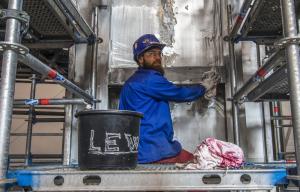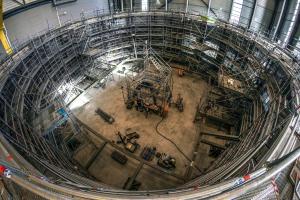Cryostat
As clean as a freshly minted coin
24 Feb 2020
Before it is encased in its protective cocoon and moved to temporary storage, the cryostat upper cylinder must be cleaned. The operation is both low-tech and essential: all the dust specks, metal particles, and traces of grease and chemicals that have accumulated during assembly and welding must be removed from both the inner and outer surfaces of the massive component. To be allowed into storage, the upper cylinder must be as clean and shiny as a freshly minted coin.
More than 2,500 square metres of stainless steel must be cleaned using cloth, demineralized water, a standard solvent and a lot of elbow grease.
The process is simple, involving just cloth, demineralized water, a standard solvent called isopropanol, and a lot of elbow grease—but the surface to be cleaned exceeds 2,500 square metres.
As operations progress, a temporary plastic film is spread over the cleaned sections, prior to wrapping with much thicker cocooning material. By the end of March, the 10-metre-tall, 430-tonne component, with a diameter of 30 metres, will be completely sealed away to protect it from water, moisture and dust.
By the end of March, the 10-metre-tall, 430-tonne component, with a diameter of 30 metres, will be completely sealed away in a protective cocoon.
Moving the upper cylinder to temporary storage on the construction platform will make room for the assembly of the top lid, whose segments are expected from Larsen & Toubro in India in July. With the assembly and welding of this final section of the cryostat (after the base, lower cylinder, and upper cylinder) a formidable industrial and technological adventure—initiated in December 2015 with the delivery of the first 12 segments of the base—will come to an end.
Learn more about cryostat manufacturing here.



